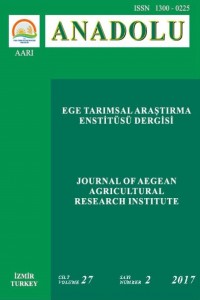Bazı Ketencik [Camelina Sativa (L.) Crantz] Populasyonlarından Seçilen Materyallerin Moleküler Karakterizasyonu
Abstract
Ketencik [Camelina sativa (L.) Crantz], Akdeniz
ve Orta Asya'ya özgü yağlı tohumlu bir bitkidir. Son yıllarda, Camelina yağı yüksek Omega-3 yağ asidi
içeriği ve biyodizel yakıt olarak kullanılma olanağı nedeniyle dünya çapında
popüler hale gelmiştir. Türkiye'nin bitki örtüsünde doğal olarak yetişmesi,
yetiştiği alanlarda diğer bitkilerle olan rekabet gücünün fazla olması ve
yüksek miktarda besin elementlerine ihtiyaç duymaması nedeniyle alternatif bir
biyodizel bitkisi haline gelmiştir. Bu çalışmada, ABD Gen Bankası’ndan ve
Türkiye Tarla Bitkileri Merkez Araştırma Enstitüsü’nden elde edilen otuz dört Camelina aksesyonundan seçilen tek
bitkilerin moleküler karakterizasyonu yapılmıştır. Bu genotipler yetmiş üç
universal ISSR markörü ile test edilmiştir. Daha sonra, genetik karakterizasyon
çalışmaları için polimorfik olan onbir primer seçilmiştir. Elde edilen
sonuçların istatistiksel analizi NTSYS-PC programında yapılmıştır. Elde edilen
dendogram ile genotipler arasındaki genetik ilişki belirlenmiş olup, bu bilgi
gelecekteki ıslah programlarına yön verebilecektir.
References
- Crowley, J. G. and A. Fröhlich. 1998. Factors Affecting the Composition and Use of Camelina. Crops Research Centre, Oak Park, Carlow.
- Frohlic, A. and B. Rice. 2005. Evaluation of Camelina sativa oil as feedstock for biodiesel production. Industrial Crops and Products 21 (1): 25-31.
- Gehringer, A., W. Friedt, W. Lühs, and R. J. Snowdon. 2006. Genetic mapping of agronomic traits in false flax (Camelina sativa subsp. sativa) Genome, 2006, 49 (12): 1555-1563.
- Ghamkhar, K., J. Croser, N. Aryamanesh, M. Campbell, N. Kon’kova, and C. Francis. 2010. Camelina [Camelina sativa (L.) Crantz] as an alternative oilseed: molecular and ecogeographic analyses. Genome 53 (7): 558-567.
- Knorzer, K. H. 1978. Evolution and spread of gold of pleasure (Camelina sativa S. L.). Ber. Dtsch. Bot. Ges. 91: 187-195.
- Kurt, O., and F., Seyis, 2008. Alternatif Yağ Bitkisi: Ketencik [Camelina sativa (L.) Crantz]. OMU. Zir. Fak. Dergisi 23 (2): 116-120.
- Mantel, N. A. 1967. The detection of disease clustering and a generalized regression approach. Cancer Res. 27: 209-220.
- Mcvay, K. A. 2008. Camelina Production in Montana: A self-learning resource from MSU Extension (MT200701AG). Available at: http://www. msuextension.org.
- Mutlu, B. 2012. Camelina. In: A.Güner, S.Aslan, T.Ekim, M.Vural, M.T.Babaç (Eds). Türkiye Bitkileri Listesi (Damarlı Bitkiler), İstanbul, Nezahat Gökyiğit Botanik Bahçesi ve Flora Araştırmaları Derneği Yayını, 2012.
- Putnam, D. H., J. T. Budin, L. A. Field, and W. M. Breene. 1993. Camelina: a promising low-input oilseed. In: Janick J, Simon J. E. (Eds.) New crops. Wiley, New York, pp. 314-322.
- Rohlf, F. J. 2000. NTSYS-pc: Numerical taxonomy and multivariate analysis system, version 2.01. Applied Biostatistics. Setauket, New York.
- Vollmann, J., H. Grausgruber, G. Stift, V. Dryzhyruk, and T. Lelley. 2005. Genetic diversity in Camelina germplasm as revealed by seed quality characteristics and RAPD polymorphism. Plant Breeding 124: 446-453.
Molecular Characterization of Materials Selected from Some Camelina [Camelina sativa (L.) Crantz] Populations
Abstract
Camelina sativa (L.) Crantz. is an
oilseed crop which is native to Mediterranean and Central Asia. In the recent
years, the Camelina oil became
popular worldwide for human consumption, Omega-3 fatty acid content and
possibility of the use as biodiesel fuel. The fact that it grows naturally in
flora of Turkey, its competition power with the other plants in the growing
field and the possibility of its cultivation without high amounts of nutrients
make it as an alternative oil plant. Molecular characterizations of single
plant, which was selected from thirty four Camelina
accessions obtained from the US Gene Bank and from the Central Research
Institute of Field Crops in Turkey, were used in this study. These seedlings
were tested with seventy-three universal ISSR markers. Then eleven markers,
which were highly polymorphic, were selected for characterization. According to
characterization results, statistical analyses were performed in NTSYS-PC.
Hence, genetic relationship between
genotypes was shown on dendrogram which will be used in breeding purpose.
References
- Crowley, J. G. and A. Fröhlich. 1998. Factors Affecting the Composition and Use of Camelina. Crops Research Centre, Oak Park, Carlow.
- Frohlic, A. and B. Rice. 2005. Evaluation of Camelina sativa oil as feedstock for biodiesel production. Industrial Crops and Products 21 (1): 25-31.
- Gehringer, A., W. Friedt, W. Lühs, and R. J. Snowdon. 2006. Genetic mapping of agronomic traits in false flax (Camelina sativa subsp. sativa) Genome, 2006, 49 (12): 1555-1563.
- Ghamkhar, K., J. Croser, N. Aryamanesh, M. Campbell, N. Kon’kova, and C. Francis. 2010. Camelina [Camelina sativa (L.) Crantz] as an alternative oilseed: molecular and ecogeographic analyses. Genome 53 (7): 558-567.
- Knorzer, K. H. 1978. Evolution and spread of gold of pleasure (Camelina sativa S. L.). Ber. Dtsch. Bot. Ges. 91: 187-195.
- Kurt, O., and F., Seyis, 2008. Alternatif Yağ Bitkisi: Ketencik [Camelina sativa (L.) Crantz]. OMU. Zir. Fak. Dergisi 23 (2): 116-120.
- Mantel, N. A. 1967. The detection of disease clustering and a generalized regression approach. Cancer Res. 27: 209-220.
- Mcvay, K. A. 2008. Camelina Production in Montana: A self-learning resource from MSU Extension (MT200701AG). Available at: http://www. msuextension.org.
- Mutlu, B. 2012. Camelina. In: A.Güner, S.Aslan, T.Ekim, M.Vural, M.T.Babaç (Eds). Türkiye Bitkileri Listesi (Damarlı Bitkiler), İstanbul, Nezahat Gökyiğit Botanik Bahçesi ve Flora Araştırmaları Derneği Yayını, 2012.
- Putnam, D. H., J. T. Budin, L. A. Field, and W. M. Breene. 1993. Camelina: a promising low-input oilseed. In: Janick J, Simon J. E. (Eds.) New crops. Wiley, New York, pp. 314-322.
- Rohlf, F. J. 2000. NTSYS-pc: Numerical taxonomy and multivariate analysis system, version 2.01. Applied Biostatistics. Setauket, New York.
- Vollmann, J., H. Grausgruber, G. Stift, V. Dryzhyruk, and T. Lelley. 2005. Genetic diversity in Camelina germplasm as revealed by seed quality characteristics and RAPD polymorphism. Plant Breeding 124: 446-453.
Details
| Primary Language | English |
|---|---|
| Journal Section | Research Articles |
| Authors | |
| Publication Date | December 15, 2017 |
| Submission Date | July 28, 2017 |
| Published in Issue | Year 2017 Volume: 27 Issue: 2 |

